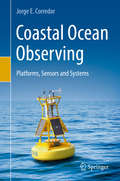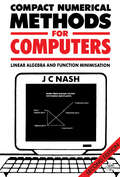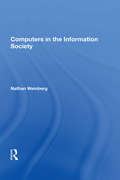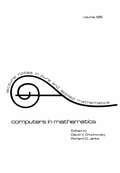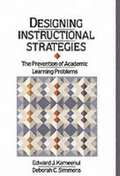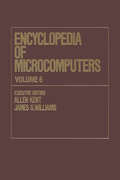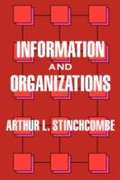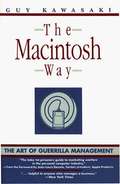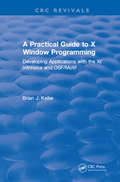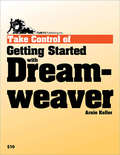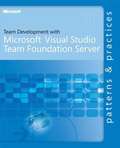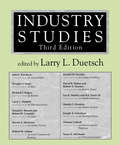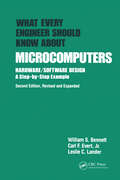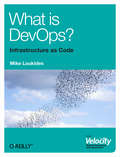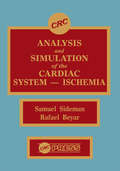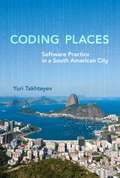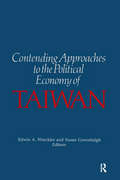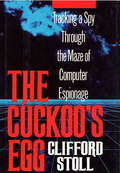- Table View
- List View
Coastal Ocean Observing: Platforms, Sensors and Systems
by Jorge E. CorredorThis manual describes the wide range of electromechanical, electrochemical and electro-optical transducers at the heart of current field-deployable ocean observing instruments. Their modes of operation, precision and accuracy are discussed in detail. Observing platforms ranging from the traditional to the most recently developed are described, as are the challenges of integrating instrument suits to individual platforms. Technical approaches are discussed to address environmental constraints on instrument and platform operation such as power sources, corrosion, biofouling and mechanical abrasion. Particular attention is also given to data generated by the networks of observing platforms that are typically integrated into value-added data visualization products, including numerical simulations or models. Readers will learn about acceptable data formats and representative model products. The last section of the book is devoted to the challenges of planning, deploying and maintaining coastal ocean observing systems. Readers will discover practical applications of ocean observations in diverse fields including natural resource conservation, commerce and recreation, safety and security, and climate change resiliency and adaptation. This volume will appeal to ocean engineers, oceanographers, commercial and recreational ocean data users, observing systems operators, and advanced undergraduate and graduate students in the field of ocean observing.
Compact Numerical Methods for Computers: Linear Algebra and Function Minimisation
by John C. NashThis second edition of Compact Numerical Methods for Computers presents reliable yet compact algorithms for computational problems. As in the previous edition, the author considers specific mathematical problems of wide applicability, develops approaches to a solution and the consequent algorithm, and provides the program steps. He emphasizes usefu
Computer Applications for Business: Step-by-step Exercises and Applications
by Iris BlancComputer Applications for Business will introduce you to word processing, spreadsheet, database and desktop presentation concepts through sequential practice material. Most of the exercises relate to computers. Consequently, while you are doing the exercises, you are also learning about computers. The exercises proceed from basic to intermediate level. Since this book is generic, it may be used with any software or computer. There are five chapters in this book: 1. Word Processing, 2. Spreadsheet, 3. Database, 4. Integration, and 5. Desktop Publishing.
Computers In The Information Society
by Nathan WeinbergThis book examines the unfolding cultural and organizational impact of computers on human society. Through this analysis, it discusses the role of information technology in people's lives, interdependence between the society and its computer creations, and expectations in the information society.
Computers in Mathematics (Lecture Notes In Pure And Applied Mathematics Ser. #Vol. 113)
by V. ChudnovskyTalks from the International Conference on Computers and Mathematics held July 29-Aug. 1, 1986, Stanford U. Some are focused on the past and future roles of computers as a research tool in such areas as number theory, analysis, special functions, combinatorics, algebraic geometry, topology, physics,
Designing Instructional Strategies: The Prevention of Academic Learnig Problem
by Edward J. Kameenui Deborah C. SimmonsDesigning Instructional Strategies: The Prevention of Academic Learning Problems is about designing and delivering instruction to students with academic learning problems. These students are identified as learning disabled, mildly handicapped, or emotionally disturbed who receive services in special education or general education settings.
The Devouring Fungus (Tales of the Computer Age)
by Karla JenningsA must for anyone who's ever considered using a RAM chip as fertilizer of booting up a computer with a steel toe. Karla Jennings' humorous history of the computer age shows that no part of our world today escapes the computer's influence. Includes witty illustrations Garry Trudeau, Rich Tennant, and others.
Encyclopedia of Microcomputers: Volume 6 - Electronic Dictionaries in Machine Translation to Evaluation of Software: Microsoft Word Version 4.0 (Microcomputers Encyclopedia Ser.)
by Allen Kent James G. Williams"The Encyclopedia of Microcomputers serves as the ideal companion reference to the popular Encyclopedia of Computer Science and Technology. Now in its 10th year of publication, this timely reference work details the broad spectrum of microcomputer technology, including microcomputer history; explains and illustrates the use of microcomputers throughout academe, business, government, and society in general; and assesses the future impact of this rapidly changing technology."
Father, Son, and Company: My Life at IBM and Beyond
by Thomas J. Watson Jr. Peter PetreAlong with the story of a father and son, this is IBM's story too. It chronicles the management insights that shaped its course and its unique corporate culture, the style that made Thomas Watson Sr. one of America's most charismatic bosses, and the daring decisions by Thomas Watson Jr. that transformed IBM into the world's largest computing company. One of the greatest business-success stories of all time, "Father, Son & Co." is a moving lesson for fathers who dream for their children, as well as a testament to American ingenuity and values, told in a disarmingly frank and eloquent voice.
The Ghost Inside the Monitor
by Margaret J. Anderson[from the back cover] "Something weird is going on in Sarah's father's new computer store. When Sarah looks at her reflection in the monitor, the face she sees isn't hers! It belongs to a younger girl, named Pascale, whose tragic story mysteriously writes itself across Sarah's computer screen. Sarah is fascinated, and then haunted, by Pascale's tale--because the little girl's ghost has a very real grip on her. Pascale repeatedly propels Sarah back in time (where Sarah is forced to relive adventures from Pascale's life in frontier Oregon) in a desperate attempt to solve the century-old mystery of her disappearance. Can Sarah find a way to bring peace to Pascale's ghost? It's either that or risk being marooned in someone else's past, perhaps for good!"
Information and Organizations
by Arthur L. StinchcombeIn a mix of theoretical insights and anecdotal material, this book explores the ins and outs of organizations from both a macro and micro perspective that has long confronted business people and those interested in organizational theory.
The Macintosh Way
by Guy KawasakiThe Macintosh Way is the take-no-prisoners guide to guerrilla marketing warfare in the personal computer software industry, celebrating passion, competition, excellence, and hard work.
A Practical Guide To X Window Programming: Developing Applications with the XT Intrinsics and OSF/Motif
by Brian J. KellerA Practical Guide to X Window Programming is a basic guide that takes readers step by step through developing applications using X-Windows. The book covers the Xt Intrinsics portion of the X-Window system in detail and discusses the MIT Athena and OSF/Motif Widget Sets that are used in many of the examples. Topics covered include C programming fundamentals, text handling using X, fonts, event handling in Xt, extending the Widget Sets (building on Field Editor Widget), designing and constructing an application, building menus, printing help, OSF/Motif (including the window arranger) and interclient communication. Three extensive appendices are included: Widgets, Classing, and Exported Functions; Quick Xt Reference Guide (X11R4); and Quick Guide to OSF/Motif Widgets. Any applications designer interested in developing applications with Xt will find this book a valuable and enlightening resource.
Quantum Computer Science
by N. David Mermin"This book is an introduction to quantum computation, developing the basic elements of this new branch of computational theory without assuming any background in physics. It begins with an introduction to quantum theory from a computer-science perspective. It illustrates the quantum-computational approach with several elementary examples of quantum speed-up, before moving to the major applications: Shot's factoring algorithm, Grover's search algorithm, and quantum error corrections. "--BOOK JACKET.
Take Control of Getting Started with Dreamweaver
by Arnie KellerLearn fundamental Web design principles and become comfortable working in Dreamweaver's complex interface! Dreamweaver 8 is a great Web design tool for pros, but newcomers may be overwhelmed by its interface or want to know more about how to work creatively and intelligently in the program. Help is at hand in Take Control of Getting Started with Dreamweaver, which offers a detailed tutorial for making your first site in Dreamweaver. Author Arnie Keller, who teaches Web design at the University of Victoria, shows you how to style type the smart way with CSS, create a sophisticated page layout using layers, and design a template-based site with an interactive navigation bar. This book also breaks new ground by linking to video screenshots (check them out now!) that show you exactly what to do. Read this book to learn the answers to questions such as: How can I experiment with different type formats? Can I control exactly where text and graphics appear on my pages? What's the best way to make a navigation bar that will help people find their way around my site? I want all my pages to have the same header and footer - how do I set up a template that automatically takes care of these repeating elements? How do I transfer my site to a Web server from within Dreamweaver?
Team Development with Visual Studio® Team Foundation Server
by Microsoft CorporationThis guide shows you how to get the most out of Visual Studio 2005 Team Foundation Server to help improve the effectiveness of your team-based software development. Whether you are already using Team Foundation Server or adopting from scratch, you'll find guidance and insights you can tailor for your specific scenarios.
Uncertainty
by M. Granger Morgan Max HenrionThis volume, like its predecessors, reflects the cutting edge of research on the automation of reasoning under uncertainty. A more pragmatic emphasis is evident, for although some papers address fundamental issues, the majority address practical issues. Topics include the relations between alternative formalisms (including possibilistic reasoning), Dempster-Shafer belief functions, non-monotonic reasoning, Bayesian and decision theoretic schemes, and new inference techniques for belief nets. New techniques are applied to important problems in medicine, vision, robotics, and natural language understanding.
Urban Politics: New York Style
by J. Bellush Dick NetzerIn many respects, New York City is an unnatural wonder, quite unlike any other American city and also unlike megacities in other industrial countries. Its government and politics, its physical attributes-like the celebrated skyline and high population density-and many of its social characteristics-like the extraordinarily high percentage of the city's population that is foreign-born-are different. But New York City at the same time shares with other American cities an array of political and governmental institutions, practices, traditions, and pressures, ranging from the long dominance and then long decline in the role of party organizations in local government to the city's ultimate dependence on outside actors and forces to shape its political destiny.
What Every Engineer Should Know about Microcomputers: Hardware/Software Design: a Step-by-step Example, Second Edition,
by William S. Bennett Carl F. Evert Jr. Leslie C. LanderRevised and expanded guide demonstrates microcomputer usage by working through one simple design challenge and explaining its solution. This edition features the contributions of an Ada expert, demonstrates (in 14 new chapters) the development of a microcomputer system structured by this language.
What is DevOps?
by Mike LoukidesHave we entered the age of NoOps infrastructures? Hardly. Old-style system administrators may be disappearing in the face of automation and cloud computing, but operations have become more significant than ever. As this O'Reilly Radar Report explains, we're moving into a more complex arrangement known as "DevOps." Mike Loukides, O'Reilly's VP of Content Strategy, provides an incisive look into this new world of operations, where IT specialists are becoming part of the development team. In an environment with thousands of servers, these specialists now write the code that maintains the infrastructure. Even applications that run in the cloud have to be resilient and fault tolerant, need to be monitored, and must adjust to huge swings in load. That was underscored by Amazon's EBS outage last year. From the discussions at O'Reilly's Velocity Conference, it's evident that many operations specialists are quickly adapting to the DevOps reality. But as a whole, the industry has just scratched the surface. This report tells you why.
Analysis and Simulation of the Cardiac System Ischemia
by Rafael Beyar Samuel SidemanOver thiry-five experts contribute to this publication about the various interactions and interrelationships of the parameters which affect the normal and ischemic heart. Mechanical aspects related to the global and regional function of the heart are discussed. Coronary perfusion of the ischemic heart is considered, with emphasis on the effects of reperfusion. Electrical activation, formation of arrhythmias, and the effects of ischemia or ionic transport in the myocardium are presented. Metabolic aspects of the ischemic heart, including calcium transport, are also explained.
Coding Places
by Yuri TakhteyevSoftware development would seem to be a quintessential example of today's Internet-enabled "knowledge work"--a global profession not bound by the constraints of geography. In Coding Places, Yuri Takhteyev looks at the work of software developers who inhabit two contexts: a geographical area--in this case, greater Rio de Janeiro--and a "world of practice," a global system of activities linked by shared meanings and joint practice. The work of the Brazilian developers, Takhteyev discovers, reveals a paradox of the world of software: it is both diffuse and sharply centralized. The world of software revolves around a handful of places--in particular, the San Francisco Bay area--that exercise substantial control over both the material and cultural elements of software production. Takhteyev shows how in this context Brazilian software developers work to find their place in the world of software and to bring its benefits to their city. Takhteyev's study closely examines Lua, an open source programming language developed in Rio but used in such internationally popular products as World of Warcraft and Angry Birds. He shows that Lua had to be separated from its local origins on the periphery in order to achieve success abroad. The developers, Portuguese speakers, used English in much of their work on Lua. By bringing to light the work that peripheral practitioners must do to give software its seeming universality, Takhteyev offers a revealing perspective on the not-so-flat world of globalization.
Contending Approaches to the Political Economy of Taiwan (Taiwan In The Modern World Ser.)
by Susan Greenhalgh Edwin A. WincklerThis work compares IT parks in China, India, Malaysia, Singapore, Taiwan, and Hawaii, in search of strategies that policy makers can employ to reduce the Global Digital Divide, advance distributional equity, and soften some of the negative effects of economic globalization.
CUCKOO'S EGG
by Clifford StollBefore the Internet became widely known as a global tool for terrorists, one perceptive U.S. citizen recognized its ominous potential. Armed with clear evidence of computer espionage, he began a highly personal quest to expose a hidden network of spies that threatened national security. But would the authorities back him up? Cliff Stoll's dramatic firsthand account is "a computer-age detective story, instantly fascinating [and] astonishingly gripping" (Smithsonian). Cliff Stoll was an astronomer turned systems manager at Lawrence Berkeley Lab when a 75-cent accounting error alerted him to the presence of an unauthorized user on his system. The hacker's code name was "Hunter"--a mysterious invader who managed to break into U.S. computer systems and steal sensitive military and security information. Stoll began a one-man hunt of his own: spying on the spy. It was a dangerous game of deception, broken codes, satellites, and missile bases--a one-man sting operation that finally gained the attention of the CIA . . . and ultimately trapped an international spy ring fueled by cash, cocaine, and the KGB.
The Cuckoo's Egg
by Clifford StollWhen computers exist hacker's coexist. Cliff Stoll found that his system was being used by someone else. It took a while for him to realize that there was a hacker behind it. So he decided to unwind the mystery by some undercover work.
